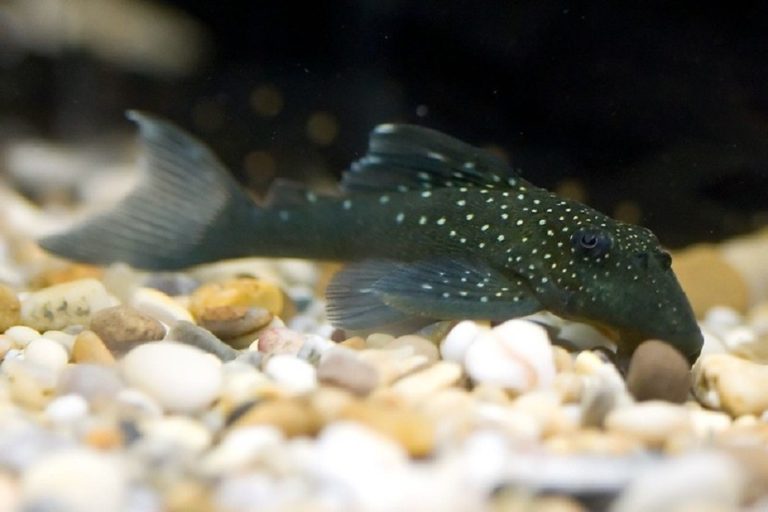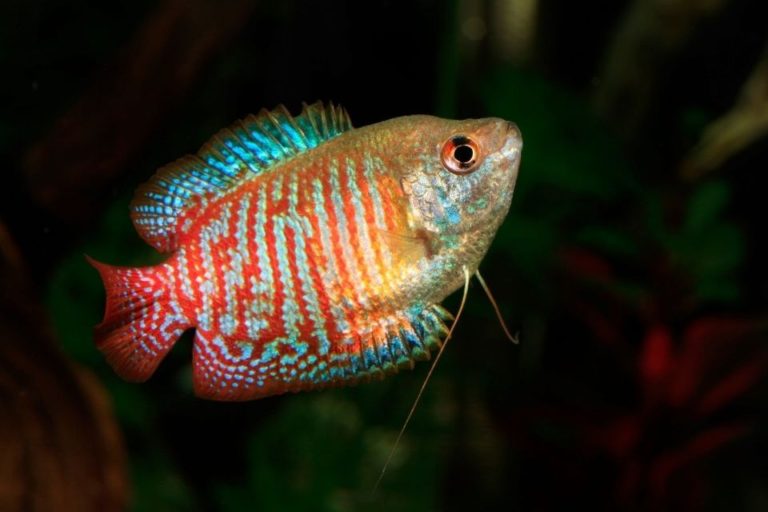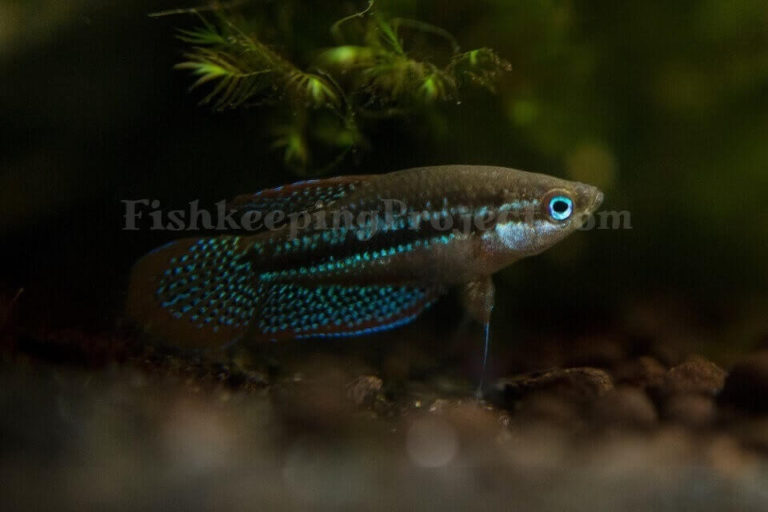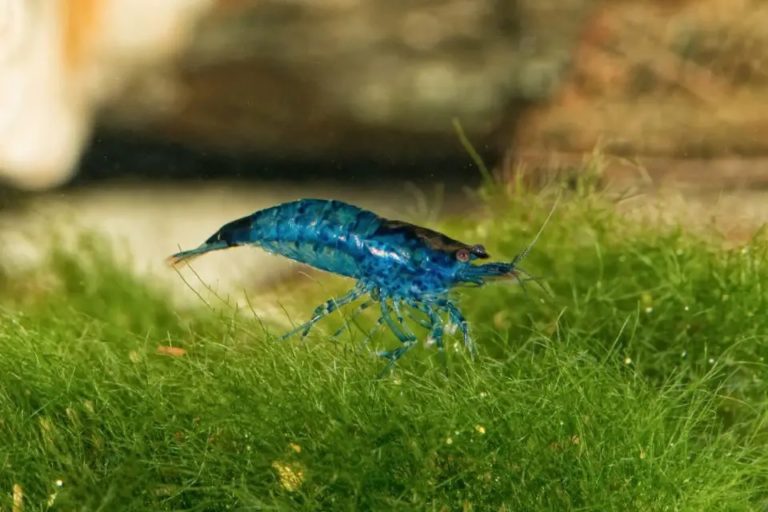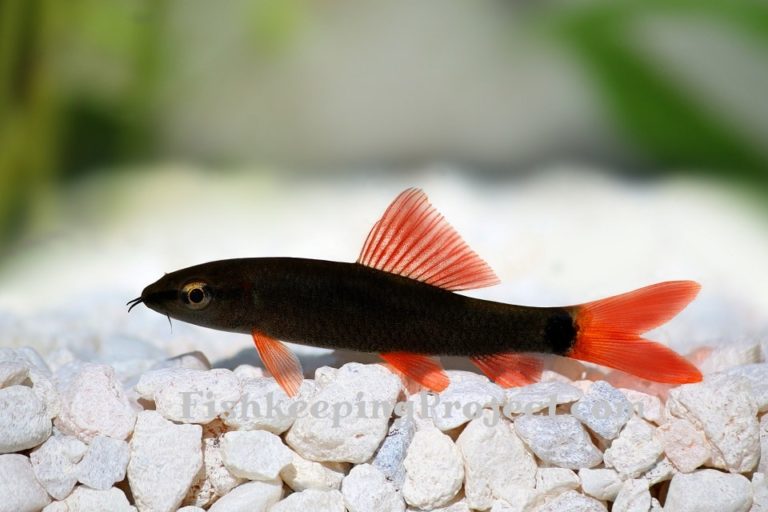Jaguar Cichlid Care: Tank Mates, Tank Size, Feeding, Size and Lifespan
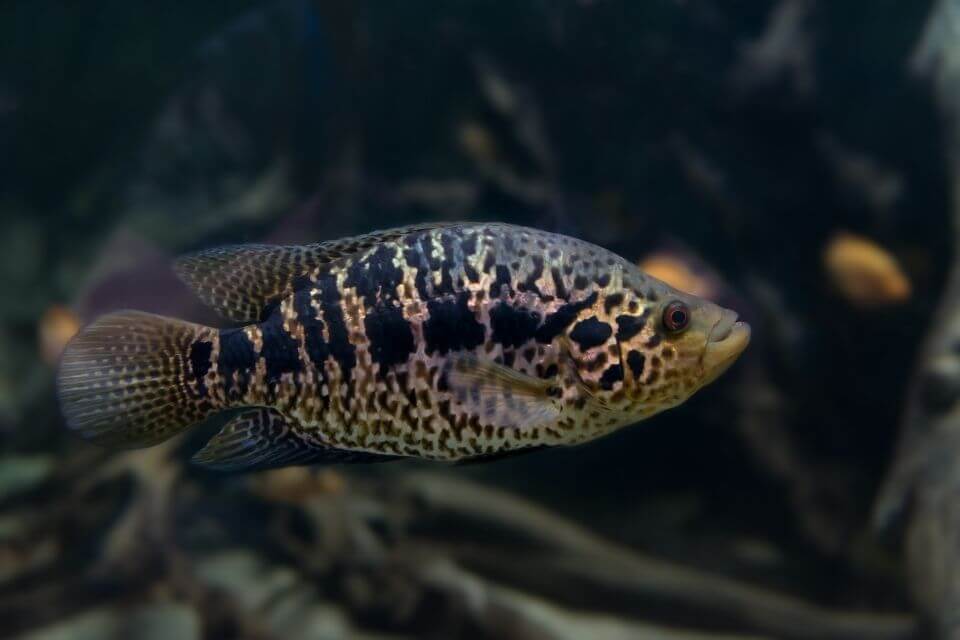
Jaguar Cichlid is one of the aggressive freshwater fish species that are known by many aquarists and hence they are very popular. However, even though many fish keepers know about them.
Most of them are intimidated by them since keeping them in the aquariums is not a walk in the park. That is because these fish are naturally aggressive and they usually grow into massive sizes.
Hence they require more space and better care than many other freshwater fish species. While as an aquarist you might be waiting until you are interested in keeping these fish.
Getting detailed information about them in advance would help to give them good care. This Jaguar Cichlid care article will act as a guide that will help you in getting more information about these fish that may be useful in the future.
| Quick Facts: | |
|---|---|
| Common Names | Jaguar Cichlid, Managua Cichlid, Managuense Cichlid, Guapote Tigre, Aztec Cichlid, Spotted Guapote, Jaguar Guapote |
| Origin | Freshwater bodies in Central America especially from Honduras to Costa Rica |
| Family | Cichlidae |
| Scientific Name | Parachromis managuensis |
| Care Level | Experienced |
| Temperament | Very aggressive |
| Social | Territorial |
| Diet | Omnivores |
| Size (average) | 14 - 16 inches |
| Lifespan | Up to 15 years |
| Breeding | Egg layer |
| Minimum Tank Size | 70 gallons (approximately 265 liters) |
| Tank Setup | Freshwater, Sand substrate, Driftwood, and Large Rocks for decorations, Floating plants. |
| Tank Temperature | 73°F – 97 °F (23 – 36 °C) |
| Water Hardness | 10 - 15 dGH |
| Water Acidity Level | 7.0 - 8.7 pH |
Species Overview
Jaguar Cichlids are scientifically known as “Parachromis managuensis” usually grow into massive sizes and are aggressive types of fish. Due to this, only experienced aquarists go for them, and hence they are not for the faint-hearted.
These fish are also called by other names derived from things such as their scientific name, their appearance, and their place of origin. Such names include Jaguar Guapote, Spotted Guapote, Tiger Guapote, Managuence Cichlid, and Aztec Cichlid.
In their natural environment, these fish are capable of growing up to 24 inches and gaining weight of up to 3.5 pounds. However, they attain much less size of up to 16 inches in a captivity environment.
Since they are aggressive Cichlid species, you should not keep them together with smaller fish or less aggressive fish.
However, these fish only get more aggressive at the time of breeding and hence you should either put them in a tank of their own or remove other fishes from the tank during that time.
Taking of these fish only gets easier if you keep them in a tank that is large enough. You should place coarse gravel, rocks, and wood at the bottom of the tank where these fish can hide and spawn.
Plants are rarely included in the tank since they are likely to be destroyed due to the aggressive nature of these fish.
Jaguar Cichlid Lifespan
A Jaguar Cichlid lifespan is about 15 years. If you decide to have this fish, you should be prepared to commit for at least 15 years because the fish can live even more than 15 years.
You can extend this lifespan and give your fish a longer life by providing optimal care and being a continuous relationship with your fish.
Jaguar Cichlid Size
Just like other Cichlid species, these fish tend to grow into a massive size. When in captivity or aquariums, Jaguar Cichlid size usually attains 14 to 16 inches. The males are a couple of inches large than the females.
It has a fairly average growth rate and Jaguar Cichlid size will reach around 24 inches in the wild with an average weight of 3 to 3.5 pounds.
If you want your Jaguar Cichlid size to grow up to 16 inches or beyond, you should have a larger tank and maintain the right water conditions, and provide high-quality food on regular basis.
Behavior & Temperament
As mentioned above, Jaguar Cichlid fish is naturally aggressive. That means that they will initiate fights with other tank mates, especially other smaller fish and invertebrates.
Due to that reason, these cannot be categorized as great community fish, and most of the time you will be forced to keep them all alone either singularly or as a pair.
Their aggressiveness tends to become worse during breeding times and hence you should always isolate them in a tank of their own until the breeding is over.
They are extremely territorial and they do not allow other fish to have peace and space in the tank if they happen to share one. They are going to do everything possible just to pick fights and kill other fish that get on their way.
As an aquarium enthusiast, you should always expect the aggressive behavior of Jaguar Cichlids if you have some or are planning to keep them. It’s a behavior that you cannot eliminate in totality but at least you can minimize it as much as possible.
You can do that by providing a tank that is large enough for your fish. On top of that, it is always good to provide the ideal water conditions for these fish as well as a healthy and adequate diet.
If you are careful enough to exercise these preventive measures, you can significantly reduce the chances of aggressiveness. Besides aggressiveness, these fish usually like to swim at the bottom half of the aquarium.
They also like digging through the substrate as well as exploring as many parts of the aquarium as much as possible. We can say that Jaguar Cichlids are generally pretty active.
Appearance And Colors
Jaguar Cichlid has stunning looks that make them a good choice for your aquarium. They have an elongated body that takes an oval shape. They have prominent dorsal fins, tail fins, and anal fins unlike other types of Cichlids.
In addition, Jaguar Cichlid has a mouth and a head that is adapted for hunting especially when in the wild. The lower jaw of their mouth extends beyond the upper jaw hence you can easily see some of the Jaguar Cichlid teeth.
Jaguar Cichlid teeth are very sharp and they can break anything that fits into its mouth. This appearance, especially protruding jaws not only makes them look good but also helps them to hunt with ease.

These fish have beautiful coloration and patterns which change as they grow old. When they are younger, they usually have a pale goldish-silver hue with large black bands on their back.
However, as they grow older, the black bands turn into dots giving them the iconic jaguar color pattern. Furthermore, they develop large splotches of black once the black bands disappear.
Jaguar Cichlid Care
Care for the Jaguar Cichlids is recommended more for experienced aquarists. That is because it can be difficult to give them the best care if you are a beginner due to their aggressiveness and massive size.
However, when it comes to maintenance and habitat factors, it is pretty easy to take care of them. That is because they are hardy and can thrive in a wide range of water conditions.
All you need to do is be consistent with the water quality and give your fish a comfortable environment. To give the best care consider the following:
– Jaguar Cichlid Tank Size
The size of the tank where you keep your Jaguar Cichlids depends on a couple of things such as the fish size and the age. When these fish are young, they usually have smaller body lengths that usually increase as they grow older.
The most critical thing is to ensure that the fish have an adequate space especially because of their aggression and activities.
You can keep a small and juvenile fish in a tank as small as 30 gallons but as it grows older be sure that it will outgrow 30 gallons. If you have a fully grown single Jaguar Cichlid, you will require at least a 70 gallons tank.
However, you can give your fish more space hence more comfort by having a larger tank. The ideal tank size that provides a single Jaguar Cichlid is an ample space to roam freely and be healthy ranging between 100 and 120 gallons tank.
When breeding Jaguar Cichlids, you can keep a breeding pair in an aquarium as big as 150 gallons tank where each fish can have its own ample space. That is because even bonded pairs will engage in fights sometimes.
– Jaguar Cichlid Tank Setup
As you do the tank setup, you should try to mimic the conditions in the wild where these fish live. However, you don’t have to worry since replicating the natural conditions is not that difficult.
As mentioned above, the lakes, the rivers, or the ponds where these fish live are usually full of plants and debris and you should create an environment with this feel for your fish.
First of all, you are supposed to add sand substrate at the bottom of the tank. The sand is very important for the fish since they like digging as one of their activities.
The sand substrate allows them to dig safely as much as they want and hence that will contribute to reducing stress. You must avoid using rough rocks and gravel that can fit into the mouth of your fish.
That is because if your fish swallows such rocks, they are likely to have digestive issues or unnecessary injuries. For decoration purposes, you can use plants, driftwood, and large rocks.
The plants that you include should either be floating plants or root types. Root plants should always be protected using pots because of the aggression and destruction behavior of Jaguar Cichlids.
The pots ensure that the plants are secure and safe. Rocks and pieces of driftwoods provide hiding places for your fish.
Decorations should always be arranged around the perimeter of the tank with only a few of them directed towards the center. That arrangement prevents overcrowding and hence allows your fish to swim comfortably in an open space.
Jaguar Cichlids are large fish and hence they produce a lot of waste within a short time which can alter the water parameters in case of insufficient filtration.
For that reason, the use of a canister filter such as Fluval FX6 is good to help in processing the waste produced by the fish.
You should not expose Jaguar Cichlids to excessive light since they are used to cloudy water because of the many plant debris floating on the water in their natural habitat.
If you expose them to too much light you might be subjecting them to stress. Also, use a strong pump to mimic the speedy water flow in their natural habitat.
– Water Conditions And Parameters
Just like the lighting, substrate, and filtration, you should always mimic in the aquarium the water parameters found in the natural habitat where Jaguar Cichlids live.
The waters in the lakes, ponds, and rivers where these fish live are usually relatively neutral and very warm. The good thing about Jaguar Cichlids is that they can tolerate changes in the water conditions, unlike other freshwater fish.
They can even thrive in waters as hot as 97 °F. However, you should be careful especially with the water temperature since too warm water may trigger aggressive behavior of this fish. It would be better to always be consistent in the ideal water conditions.
- Water temperature: 73°F – 97 °F
- Acidity levels: 7.0 – 8.7 pH
- Water hardness range: 10 – 15 dGH
– Suitable Plants
The use of floating plants is a better choice than root plants. That is because floating plants are not destroyed by Jaguar Cichlids, unlike the root plants.
Furthermore, floating plants help to provide shade hence diffusing the light that reaches the fish. The best floating plants to use are Brazilian Pennywort and Duckweed.
If you decide to use rhizome plants such as Java Fern, Amazon Sword plant, and Anubias, ensure that you attach them to driftwood or rocks.
– Possible Diseases And Prevention
Even though Jaguar Cichlids are resilient, they are not immune to health issues. However, you can do one or two things to keep your fish as healthy and protected as possible.
One is that since Jaguar Cichlids are tough fish, you can reduce the chances of illnesses by providing them with the right water conditions. These fish are not prone to serious diseases but they usually get infected with common freshwater health infections such as ich.
Ich is an infection that affects not only Jaguar Cichlids but also other freshwater fish. Ich infection can get severe and is usually caused by stress. The easiest way that you can know that your fish has Ich is when they get white dots all over their body.
Once you see this sign, it is good to act swiftly to reduce the chances of your fish dying. Since Ich is also highly contagious, taking care of it earlier helps to protect other fish in the aquarium.
The best way to keep Ich at bay is by ensuring that the water conditions are ideal. Make water conditions adjustments as soon as they are needed. That includes changing the water regularly to prevent the accumulation of ammonia and nitrates.
Diet And Feeding
High-quality food is vital for Jaguar Cichlids since it helps to keep them healthy and prevent or reduce their aggressive behavior.
They are carnivorous fish and hence they do well with a protein-based diet such as feeder fish, insects, and worms. You can also introduce them to frozen foods and dry foods like flakes and pellets from a young age.
Difference of Male Jaguar Cichlid vs Female Jaguar Cichlid
You can tell the difference between the male Jaguar Cichlid and the female Jaguar Cichlid based on the body size and the types of bars on their body.
The male is usually a couple of inches bigger than the female and has more broken vertical bars at a young age which then disappears completely when it is fully mature.
The female on the other hand is a few inches smaller and has thinner vertical bars accompanied by one dark broken horizontal bar that is more pronounced.
Jaguar Cichlid Breeding
During breeding, Jaguar Cichlids usually pair up and become more aggressive. When you notice such behavior, you should separate them from other tank mates and transfer them to a very large tank.
You can trigger and fasten breeding by slightly increasing the water temperature, changing the water up to 50% a few times per week, and providing your fish with high-quality food.
The female wells up and lays more than 2000 orange eggs on a flat rock or cave and the male fertilizes the eggs. The eggs will take 5 to 7 days before they hatch and during that time both the male and the female are very protective of the eggs.
After hatching, the baby fish will take about one week before they can swim. When they start swimming, provide them with baby brine shrimp as food.
Jaguar Cichlid Tank Mates
To ensure that the Jaguar Cichlid tank mates that you introduce are not converted into food, it is a good idea to fully understand their temperament and behavior.
The best jaguar cichlid tank mates tankmates that are already bonded together. If you have to put the Jaguar Cichlids with other fish, they have to be of the same body size.
Other large Cichlids and fish that you can use as Jaguar Cichlid tank mates are:
- Oscar Fish
- Convict Cichlid
- Flowerhorn Cichlid
- Green Terror Cichlid
- Red Devil Cichlid
- Jack Dempsey Cichlid
- Redtail Catfish
- Giant Gourami
- Sailfin Pleco
- Texas Cichlid
- Wolf Cichlid
- Bala Shark
Origin And Distribution
Gunther was the first person that noticed Jaguar Cichlid back in 1867. The fish is native to the Central American small water bodies like lakes, rivers, and river basins.
The fish is particularly found in Nicaragua’s Managua Lake, the Matina River in Costa Rica, and River Ulua in Honduras. Today the fish has been distributed far and wide in many countries.
Due to the gluttonous and aggressive nature of Jaguar Cichlids, there is considerable damage done to other marine animals like smaller fish or invertebrates and the flora in these water bodies.
As a result of marine exports and imports, you can find Jaguar Cichlid in countries such as Mexico, the USA, Singapore, Salvador, Panama, and Guatemala.
These fish are hardy and hence tolerant to a wide range of conditions in the lakes, streams, and river basins. In some countries, these fish are used for food purposes while in other countries they are only kept for a hobby as pets.
These fish usually love to stay in turbid waters with muddy bottoms and they are mostly found in warm waters with low oxygen levels.
Frequently Asked Questions
How Many Jaguar Cichlids Should Be Kept Together?
You can keep Jaguar Cichlids singularly, but keeping them as bonded pairs is the best. The bonded pair lives happily together and it should be one male and one female in an aquarium of at least 150 gallons.
Can Jaguar Cichlid Live With Oscars?
The Oscar is an excellent tank mate for Jaguar Cichlid. That is because Oscars have the same body size as a Jaguar Cichlid and sometimes they even grow bigger. Oscars can attain between 12 and 18 inches and they become terrestrial as they grow older. They are also semi-aggressive, especially when feeding and hence they are never scared away by Jaguar Cichlids.
Do Jaguar Cichlids Eat Snails?
Jaguar Cichlids usually eat snails but they do not actively hunt them. Instead, they like other live invertebrates such as worms, crickets, and insects more than snails.
Are Jaguar Cichlids Aggressive?
Yes. Jaguar Cichlids are aggressive. They are extremely terrestrial and they always pick fights with other fish or invertebrates that get on their way.
They show their aggression mostly when feeding or breeding and they will always do anything possible to kill any fish that crosses them. You should therefore be careful in selecting tank mates for these fish.
Do Jaguar Cichlids Have Teeth?
Yes, Jaguar Cichlids teeth are very sharp and strong jaws that can protrude up to 90% of the mouth length. Because Jaguar Cichlids teeth are strong canine-like, and sharp to enable them to kill their prey with ease.
Do Jaguar Cichlids Grow Fast?
Yes, Jaguar Cichlids have a speedy growth rate. They can attain a body size of up to three-quarters of an inch within the first 6 weeks of their life.
They are well guarded by their parents within this period before the parents are ready to spawn other babies.
Is Jaguar Cichlid Edible?
Jaguar Cichlids are edible. They are considered a nutritious food fish in Central America and there are no precautions released by health officials warning against eating these fish.
Furthermore, it has been listed as a least-concern species by UCN (the International Union for Conservation of Nature).
Where Is Jaguar Cichlid For Sale?
You can find Jaguar Cichlids in fish stores near you or you can as well buy them online. Ensure that you pick healthy fish that are free of infections when buying.
How Much Does a Jaguar Cichlid Cost?
Jaguar Cichlids are moderately priced when young but become more expensive as they grow older and bigger. You can get them at a price between $9 and $24 depending on age and size.
Final Thoughts
In conclusion, now that you have critical information on how to take care of Jaguar Cichlids, it is on you to decide whether you are ready to keep one or not.
If you are a beginner in aquarium fishkeeping, it is recommended that you start with other freshwater species then gradually embark on Jaguar Cichlids.
If you are an experienced aquarist, on the other hand, you can accept the challenge of keeping Jaguar Cichlids. Owning this fish will enhance your skills as an aquarist because of the intense care it needs.
Furthermore, owning fish that require intense care will lead to more rewards than keeping other fish.


